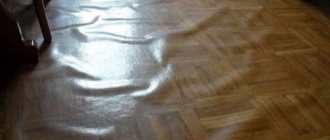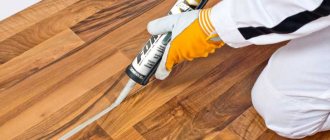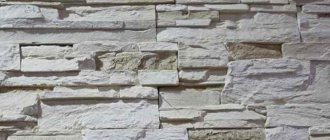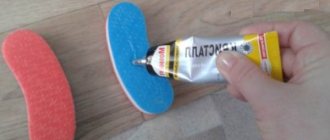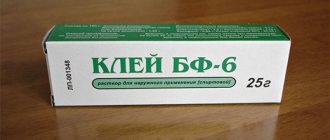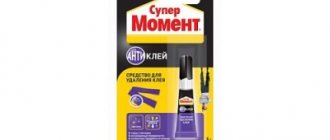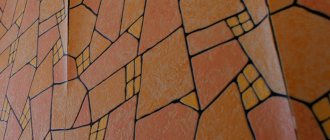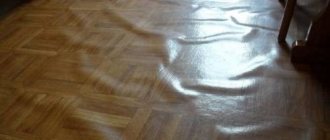According to the technology, linoleum should be laid on an adhesive layer, which ensures reliable fixation of the coating to the floor. Since linoleum can be different, the appropriate glue must be used in each specific case, otherwise a high-quality result will not work.
Adhesive for linoleum
What types of glue exist, how to choose the right composition, and is it possible to do without gluing the canvas to the surface?
Laying coating with glue: pros and cons
Should I glue linoleum or not? Manufacturers of this coating clearly support the adhesive installation method, but there is no consensus among buyers. As practice shows, a lot depends on the quality of the coating and the intensity of the load: in some cases, linoleum lays well for years without glue, in others, the glued one goes in waves and becomes deformed.
Linoleum surface defect
And yet, some kind of fixation must be present to prevent the canvas from moving.
There are several ways to fix linoleum to the floor:
- the coating is glued to double-sided tape, which is attached in parallel strips at certain intervals over the entire area. The fabrics are secured to the seams with the same tape or “cold welding” glue;
- if the room is spacious and the covering is laid in one large-width sheet (from 3 m), the glue is applied to the floor in a continuous, uniform layer;
- To fix standard sheets, glue is applied in strips along the perimeter of the area and at the seams.
The process of laying linoleum covering on tape
The first option is the most convenient and fastest, but it is not intended for intense floor loads. But the adhesive method is suitable for any premises, the main thing is to choose and apply the composition correctly.
Applying glue under the linoleum sheet
Using glue has many advantages:
- the adhesive layer ensures reliable contact of the canvas with the base, increasing the wear resistance of the coating;
- prevents the formation of waves and other deformations on the surface;
- reduces the risk of damage to the canvas when moving heavy objects;
- ensures the integrity of the seams between the canvases, due to which the coating retains its attractive appearance longer;
- extends the service life of linoleum by 30-40%.
Glue helps to avoid shifting and deformation of the linoleum sheet
This method also has disadvantages, but they are few:
- installation costs increase;
- Before using the coating, you must wait until the glue has completely dried;
- In case of dismantling, linoleum cannot always be removed without damage.
Removing glued linoleum is problematic
As for leveling the floor under linoleum, there is no difference: both for laying on a dry base, and in the case of gluing the canvas, the working surface must be perfectly flat and smooth. The adhesive layer is quite thin and cannot compensate for differences of more than 1-2 mm, so any defects will appear on the surface of the linoleum.
It is desirable that the base is level
The exception is special mastics, the application thickness of which ranges from 3 to 7 mm. They fill small irregularities well and, after curing, form a strong, reliable base for the coating. But such installation will not be cheap, since mastic is more expensive than glue, and its consumption is greater.
Using cold welding for joints and seams
The process includes the following operations:
- 2 sheets are overlapped with an overlap of 5 cm, under which you need to place a sheet of plywood in advance, and make a mark on the top sheet indicating the joint.
- Then the excess pieces are cut off from two canvases at the same time, and the canvases are joined to form a seam.
- Next, a special nozzle similar to a needle is put on the tube with the adhesive mixture, through which the solution is fed into the gap between the sheets until the glue appears as a spot on the tape. Now the nozzle needs to be moved along the seam. Next you need to wait 15 minutes, then remove the tape. The glue takes 3 hours to dry.
Cold welding is a great way to make joints smooth and reliable.
Cold welding is a great way to make joints smooth and reliable. This will require a special glue, the effect of which leads to a chemical interaction, after which the material becomes liquid, forming a reliable adhesion to the floor.
Types and characteristics of glue
The choice of adhesive depends on the surface on which the installation is being made and the type of coating itself. At the moment, linoleum adhesives are presented in dispersion and reaction compositions.
Dispersive
This type includes water-soluble compounds containing cellulose acid, acrylic, latex, rubber, chalk. They are the safest for health, do not emit a smell, and have good elasticity. They are used for natural and PVC linoleum on different types of bases - felt, fabric and foam.
Adhesive for commercial and semi-commercial linoleum, water-dispersion
The presence of water in the composition causes some restrictions: dispersion adhesive can only be applied to an absorbent base, in dry rooms where the temperature does not fall below 15°C and the humidity does not exceed 60%. The adhesive layer must not be allowed to freeze, as this will cause the material to lose its elasticity and begin to crumble.
Special water-dispersion adhesive for PVC coatings
The group of dispersion adhesives includes:
- acrylate glue - a mixture based on acrylic resin. It is characterized by high adhesion and viscosity, which ensures excellent adhesion of the coating to the floor. Can be used for homogeneous and heterogeneous linoleum with jute and synthetic base;
- Bustilate is a synthetic water-soluble composition with latex, chalk and cellulose thickener. It has high tear strength and elasticity, best suited for thick linoleum on a dense felt base;
- humilax – the composition is based on a mixture of rubber and latex, thanks to which the adhesive is easy to apply, has high elasticity and adhesion to various types of surfaces. Suitable for natural and synthetic linoleum with felt and fabric backing.
Dispersion adhesive for natural linoleum
Reactionary
This type combines two-component compositions containing polymers and epoxy resin. Bonding of surfaces occurs as a result of a chemical reaction, which is caused by mixing the components. This type of glue contains a solvent, therefore it has a pungent odor and is a flammable substance. The advantage of such compositions is the absence of shrinkage, plasticity and resistance to moisture, and they are used mainly for sealing joints between sheets and repairing damage.
Two-component epoxy-polyurethane adhesive for linoleum
Three types of two-component glue are available, differing in their consistency:
- type A is the most liquid, used for all types of linoleum on a rigid basis. It is used to seal joints when laying a new coating, as it forms an almost invisible, but very strong seam. It takes about an hour to fully cure;
- type C - a viscous transparent composition, used for sealing open seams on used flooring. Capable of closing gaps up to 4 mm;
- type T - paste-like composition for fastening seams on PVC linoleum with a polyester base. Intended for professional use, so it is rarely used by home craftsmen.
Advice. When applying these compounds, you must do everything very carefully, because glue that accidentally gets on the canvas will melt the top layer of the coating and leave a noticeable mark.
Popular brands of adhesives for linoleum
| Name | Main characteristics |
EXPERT Glue Bustilat | Suitable for gluing artificial surfaces to concrete, wooden floors, chipboard, OSB. Used for PVC linoleum on a jute base and felt. Consumption per meter of area is 500-600 g with continuous application, dries within 24 hours at a temperature of 20 ° C |
PVA glue “Universal” | Thick composition with the addition of latex. It has a wide range of applications, suitable for felt-based linoleum when laid on chipboard, OSB, wood, and concrete screed. Consumption per square meter is 200-500 g. Drying takes 24 hours at a temperature of 18-20°C |
Clay Polynom 105 | Acrylic composition for all types of linoleum, regardless of the base. Can be used on any surface. Consumption for continuous application is about 300-400 g/m2, drying time is at least 12 hours |
Homakoll 208 glue | Viscous polymer composition for roll coverings on fabric, pile and foam bases. Used only on moisture-absorbing surfaces - concrete and cement screed, plank floors, chipboard, OSB. Consumption for continuous application is 300-500 g/m2 |
Thomsit L 240 D glue | Acrylic paste composition intended for gluing natural linoleum to absorbent substrates. Can be used on heated floors. When applied continuously, the consumption is 450 g/m2, complete drying time is 72 hours |
Frost-resistant adhesive for natural linoleum
How to glue linoleum to a wooden floor
The gluing technology is no different from previous ones. The most important thing is to level the wooden floor and clean it thoroughly. Any water-dispersed adhesive for absorbent substrates can be used as an adhesive composition. Also suitable are universal adhesives homakoll 208 and homakoll 164 prof with increased stickiness, regardless of what primer the base is coated with.
Recommendations for choosing and using glue
So, the main criterion when choosing an adhesive is the type of subfloor. Absorbent and non-absorbent substrates use different formulations, and if you use the wrong adhesive, a strong bond will not work. Absorbent surfaces include cement and concrete screed, solid wood, plywood flooring, chipboard, fiberboard, OSB.
Wood is a highly absorbent surface
Linoleum is glued to them with water-soluble compounds, but this also has its own nuances. Board materials such as plywood, fiberboard and others can become deformed from excess moisture, so for them you need to choose thick adhesive mixtures with a minimum water content. For a concrete floor, the consistency of the glue is not particularly important.
If the floor is concrete, the consistency of the glue can be any
Floors lined with natural stone, porcelain stoneware, and tiles are considered non-absorbent. Here, water-soluble compounds will be ineffective, since there is nowhere for moisture to escape, and high-quality adhesion between surfaces will not work. For such bases, reaction adhesives are used, when applying which it is necessary to take precautions - use protective gloves and masks, ventilate the room.
If the floor has tiles, it is better to use reaction adhesive
You need to buy glue along with or after linoleum to make sure that the composition is suitable for this particular coating. The glue packaging always indicates what types of linoleum it is suitable for and what the coating base should be. Be sure to check the expiration date, because expired glue will not hold the canvas. It is best to buy adhesive compositions in construction supermarkets or large stores where there are conditions for proper storage of such materials. This is especially true for water-soluble adhesives, which completely lose their adhesive properties after freezing. The exception is special dispersions with frost-resistant additives: they can withstand 3 to 5 cycles of freezing and thawing without losing their basic characteristics.
Universal adhesive fixer for linoleum and carpet Axton
Information about the glue is always on the packaging
This is what linoleum glue looks like
In order not to overpay, before purchasing you should calculate the required amount of glue. To do this, you first need to take measurements of the room and calculate the total coverage area. As a rule, consumption varies between 200-500 g per m2 (this is influenced by the type of working surface and coating base). For example, a fabric or felt base requires more glue than foam and rubber, and a plank floor requires more than a concrete screed.
To reduce glue consumption, it is recommended to prime the floor. Glue should be purchased with a small supply so that you do not have to interrupt installation and go back to the store.
Primer concrete-contact
Acrylic primer for wood floors
The photo shows the process of priming a wooden floor under linoleum
Advice. You cannot mix glue of different brands, even if the name of the composition is the same. Each manufacturer has its own manufacturing technology, so the compositions may differ in the number of components, drying time, peel strength and other characteristics.
Linoleum and glue must be kept in the room where the covering will be laid for at least 24 hours. Work should be carried out at a temperature not lower than 15°C and air humidity not higher than 75%. In this case, the humidity of the floor base should not exceed 8% for wood and 2% for screed.
Let the linoleum sit at room temperature for 24 hours
Immediately after applying the glue, you cannot lay linoleum; you need to let the composition dry a little for 5-10 minutes (the exact drying time is indicated on the packaging). Also, you should not apply glue in a thick layer: this will not make the fabric stick better, and excess glue will appear as thickenings and bumps on the surface of the linoleum.
How to glue linoleum to fiberboard on the floor
Fiberboard is an excellent underlay that is often used to level floors. If the room is dominated by dry air and there are no temperature fluctuations, then this coating will be a good base for linoleum. And considering that fiberboard is easy to install and has a low cost, we can safely say that this material is a favorite among installers.
To glue linoleum to fiberboard, use the universal adhesive homakoll 164 prof with increased stickiness and long open working time, or the more economical homakoll 208. And in rooms with high traffic, you can use adhesive for semi-commercial linoleum homakoll 248.
All of them have a thick consistency and are conveniently applied with a spatula.
Procedure for laying linoleum on glue
Laying and gluing linoleum is not difficult, although many beginners still make mistakes. Let's look at how to properly lay the coating with glue so that you don't have to redo anything.
Step 1. The floor is cleaned of debris, dust, old paint or glue, mastic, and greasy stains. Eliminate cracks and unevenness, if necessary, use leveling mixtures. The base must be smooth, strong, dry and clean.
Step 2. The surface is treated with a primer using a roller. It is recommended to use primer and adhesive from the same manufacturer. After applying the primer, leave the room until the floor is completely dry.
Applying primer to the floor
Step 3. Roll out the linoleum sheet on the floor and align it with the walls. If the coating consists of several strips, mark the location of the canvas with a pencil so that the layer of glue does not protrude beyond the edge. After this, turn the linoleum halfway towards the center of the strip.
Step 4. Mix the glue in the container thoroughly; if a film has formed on top, it must be carefully removed. Apply the composition with a special spatula A2 or B1 with small teeth. The mixture is evenly distributed over the surface so that there are no sagging or dry areas. Let it dry for a few minutes.
Spatula A2
Applying glue with a notched trowel
Step 5. Slowly and carefully return the folded edge of the linoleum to its place, simultaneously straightening the edges. There should be no creases, folds or other irregularities on the canvas.
The linoleum sheet is unrolled while gluing
Step 6. Having rolled out the coating, begin to smooth it out. It is very important that there are no air bubbles left under the canvas, otherwise the linoleum will not stick completely and will swell in places.
It is important to smooth the fabric well
Step 7. Next, turn off the covering on the other side and repeat all the steps again. The remaining strips of linoleum are glued in the same way, carefully adjusting at the joints.
The next linoleum sheet
Applying glue
Step 8. After gluing, trim the material near the walls and clean the seams from any remaining glue. After this, take a break for 1-2 days until the adhesive layer dries completely.
Step 9. Now you can glue the seams. Using a special tool or a sharp mounting knife under a ruler, cut off all the irregularities at the joints of the strips and clean the seams along the entire length. Cold or hot welding is used for connection. Processing seams requires great care and should not be rushed, because uneven joints will be clearly visible on the coating.
Hot seam welding
Seam trimming
After hot welding, it is necessary to cut off the welding cord protruding above the surface of the linoleum. First, a rough trim is performed, then the remaining defects are cleaned up.
Hot welding of linoleum
If cold welding is used, the seam must first be sealed with masking tape, then cut with a knife exactly in the center. The tip of a tube of glue is inserted into the hole and passed along the joint, squeezing out the mixture into a thin strip. After this, wipe off the remaining glue and remove the tape.
Cold welding of linoleum
After laying the linoleum, install the skirting boards
Prices for Ceresit tile adhesive
Ceresit tile adhesive
Is it necessary to glue linoleum?
Note
Those who risk laying the covering without fixing it face:
- fungus formation
- waves on the carpet,
- bubbles with folds,
- damage when moving furniture.
If we consider harder PVC coatings, then unevenness and swelling can be observed in those places where the coating does not have a strong bond with the base. Such areas are the first to suffer from wear and tear.
Soft household coverings are subject to change in size due to fluctuations in humidity and temperature. During the winter season, when the rooms are heated, linoleum shrinks. If the coating is not glued, then gaps will form between the joints. With the onset of spring and increased air humidity, the linoleum stretches again and then bubbles appear on the surface, which are almost impossible to fight.
To avoid defects when installing the floor covering, it is recommended to use the adhesive method.
Dispersive
This is an adhesive in the form of finely divided polymers in a liquid that can be used immediately after opening the package.
The main component of the substance is water. It is combined with various additives, such as:
- Acrylic, paint;
- Cellulosic acids;
- Chalk;
- Resin.
The composition has become widespread due to the following technical characteristics:
- High operating temperature – up to +15 degrees Celsius.
- Can be used for heated floors.
- 100% guarantees safety for humans.
- Increased level of adhesion.
- Durability and resistance to heavy loads.
It is important to know that the humidity in the room should not exceed 60%, and the temperature should not be lower than specified. Without following the operating rules, the material is destroyed beyond the possibility of restoration.
Common types:
| Representative | Compound | Where is it used? |
| Bustilat | Latex, chalk, carbomethylcellulose | For gluing felt-based linoleums. |
| Gumilax | Rubber, latex | For felt and synthetic coverings. |
| Acrylate | Thermoplastic resin | For homogeneously coated surfaces. |
What to do if linoleum starts to peel off
It often happens that the fixed coating peels off from the floor after some time and requires repair. How to fix the defect? If swelling occurs, you can make a puncture in the fabric using a thin awl. The air is then released and the area is ironed with a hot iron through a thin sheet of white paper. The glue melts and re-bonds the surfaces.
Gluing joints together
How to glue linoleum together if the fabric comes apart at the joints? The separation of the seam indicates a violation of the cold welding technology. The resulting defect can be easily eliminated - the seam is cleaned and degreased with alcohol and gasoline. Then the coating is carefully folded back and an adhesive is applied underneath it. Next, the joints are fastened by cold welding.
Is there a difference between gluing linoleum in an apartment and in a country house?
In country houses in rooms with high traffic, such as the kitchen and corridor, it is advisable to use linoleum of at least class 32, which is much more resistant to various mechanical influences. Homakoll 248 or Homakoll 148 is used with this coating.
For bedrooms, household linoleum in combination with homakoll 208 and homakoll 268 glue is suitable.
How to lay linoleum (video)
If you are thinking about what kind of adhesive to attach to a floor surface, it is worth considering reaction types. They are based on epoxy resin and polyurethane. As a result, linoleum turns out to be reliable; it is not afraid of chemical stress. An ideal variety for gluing fabric-based materials.
Among the disadvantages, it is worth noting the pungent odor and high cost. The connection of the seams in this case is called cold welding due to the chemical reaction that occurs.
How to glue to old linoleum
Installation of linoleum should be carried out on a rigid, level base. And for this case, old linoleum will not be a completely suitable substrate, since the material is flexible and soft. We recommend that you first dismantle the first layer, prepare the base, and then lay a new one. Laying linoleum on an old coating risks the formation of mold and repetition of the defects of the previous layer.
The practice of laying linoleum on linoleum still exists. If you still decide to do this, make sure that your coating has not lost its elasticity and is not damaged, otherwise the coating should definitely be dismantled.
For gluing linoleum, glue for non-absorbent substrates is suitable, for example, homakoll 268 for residential sectors and homakoll 164 for commercial sectors.
How to glue linoleum to plywood
Any base under linoleum must be strong, level and dry. Laying sheets of plywood is often chosen as one of the methods for leveling the floor. After installation, the plywood is sanded to remove burrs, the screw heads are puttied, as well as the seams between the panels.
With proper preparation of plywood sheets, the base becomes durable and moisture resistant. After cleaning the base, the linoleum is spread and left for 2 days to acclimatize.
A suitable adhesive for gluing linoleum to plywood is a water-dispersible adhesive for absorbent substrates.
Useful tips
Algorithm for performing operations:
- Linoleum is laid out for acclimatization for 1-2 days;
- the base is prepared (cleaned of dust and dirt, cracks are sealed, the surface is leveled);
- primer is applied;
- linoleum is cut in place (leaving gaps around the perimeter between the canvas and the walls);
- linoleum is glued;
- pressed and smoothed (to remove air). Adhesive compositions must reliably fix the linoleum, prevent it from shifting, the appearance of fungus, bubbles, ensure the removal of the coating (if necessary) and not destroy the base.
How to glue correctly step by step instructions
The technology for installing natural and vinyl elastic coatings is in many ways similar, so here we will give a description of working with PVC coatings with some remarks. First you need to prepare a set of auxiliary tools. You will need:
- Construction vacuum cleaner for cleaning surfaces from dust;
- Knife with hook for cutting linoleum. You can use a regular construction knife with replaceable blades;
- Steel ruler or level;
- Tape measure and marker;
- Notched trowel or short-haired roller for applying glue;
- Lapping board, weighted or regular rolling roller for smoothing linoleum to the base;
- Double-sided tape and cold welding glue for fixing seams;
- Skirting boards with fittings, as well as decorative metal or PVC thresholds.
It is necessary to glue indoors when:
- Air temperature not lower than +15 °C;
- Base temperature – from +14 °C to +25 °C;
- Relative air humidity – up to 75%;
- The humidity of a concrete or cement-sand base is up to 4%, anhydrite – 0.5, dry prefabricated screed – up to 8%.
Don’t forget to give the covering time to acclimatize when spread out - at least 24 hours during warm periods and up to 3 days during cold periods. Natural linoleum is left indoors in the form of a vertically standing roll for the same period.
If the base meets the requirements for strength, moisture, evenness and hardness, then you can begin laying linoleum with glue.
Checking the base for levelness.
Work order:
Preparing the base floor
Includes:
- Checking the base for evenness. All pits and cavities must be filled with repair mixtures, and tubercles and protrusions must be cleaned to the general surface level;
- Turn off the floor heating system at least 3 days before the start of work;
- Cleaning the surface of old coatings, paint residues, bitumen and oil stains, dust, soot, soot;
- Priming with a primer appropriate to the base - waterproofing, strengthening, improving adhesion and equalizing absorbency.
Natural and vinyl linoleum products can be laid over old ones using special adhesives (Forbo 522 Eurosafe Star Tack, UZIN KE 2428, etc.). But only if the coatings have a dense structure, a thickness of up to 2 mm and an undamaged surface.
Linoleum fitting
If the flooring material is laid as one canvas, then the canvas must be placed tightly against a flat wall and leveled. You can temporarily fix it around the perimeter with double-sided tape. Carefully cut off the excess, taking into account the compensation gap of 5-10 mm, and also cut along the external and internal corners. Cutting is carried out in the following way: the covering is pressed to the point where the wall and floor meet, it is cut crosswise, then it is carefully folded back, and the excess is cut off.
Adjusting linoleum when laying.
When laying several canvases you must:
- Combine decor correctly. In case of a blurred pattern without clearly defined boundaries (marble chips, cork, flock, plain), it is recommended to lay PVC-coating canvases reversely (that is, in opposite directions), and natural ones - in one direction. Products designed to look like wood or tiles are also laid one-sided, taking into account rapport.
- Form a tight joint. To do this, the vinyl layers need to be laid with an overlap of 2-5 cm, pressed to the base with a metal ruler and cut through both layers with a knife. When working with natural linoleum, the technique is slightly different: the ends are trimmed with a slightly inclined knife so that when the panels are combined, they touch with their upper sharp edges. During the fixing process, the edges are slightly wrinkled and form a tight seam without the slightest gaps.
Gluing
The cut fabric is bent to half its length, and the unnecessary adhesive tape is removed. The glue should be applied in small portions, evenly distributed over the surface with a notched trowel or roller. After a technological break necessary for the adhesive composition to partially polymerize (from 10 to 30 minutes depending on the type of compound), the linoleum is slowly rolled out and smoothed with a lapping board or rolling roller.
This will remove air bubbles and ensure the tightest connection between the base and the finish coat. Next, glue the remaining half of the finishing material in the same way. After 1-3 days, you can begin welding seams, as well as fastening skirting boards, thresholds and other decorative elements.
We tried how to work with linoleum from household series. Commercial and special coatings require serious preparation of the base, the presence of special equipment, knowledge of many subtleties, etc. Therefore, it is better to entrust work with them to professional teams.
Examples
We bring to your attention examples of the most famous brands of linoleum adhesives; with a high probability we can say that one of them will be at your disposal:
- "Werner Müller" type "A" for cold welding. Suitable for welding both domestic and commercial linoleum, both short and long seams. The manufacturer's recommended consumption is one tube per 10 meters of seam.
- "Thomsit K 198" for heterogeneous and homogeneous PVC linoleums.
- "Werner Müller" type C for cold welding of wide seams. Consumption – one tube per 7 meters.
- "Homakol 208" is a universal water-dispersion adhesive based on PVA with resins.
- "Homakol 248" is a water-dispersion adhesive for gluing homogeneous and heterogeneous linoleum.
- "LINOCOL" - for gluing seams of PVC linoleum on a foam base. The result is a perfect, completely invisible seam.
- Forbo Erfurt 525 is a solvent-free dispersion adhesive with fast setting.
- "Forbo-Erfurt 522" is a dispersion adhesive for working on any type of floor.
- "Forbo Erfurt 523" is a light, conductive dispersion adhesive with high adhesive ability, but requires use on surfaces prepared with a conductive dispersion primer or on a mesh of copper tape.
- "Forbo Erfurt 578" is a frost-resistant adhesive for textile and vinyl coverings, capable of restoring its characteristics after defrosting, although it requires strict adherence to all technologies.
If you are laying linoleum on an electrically insulated floor, then, depending on the technology, it is often necessary to use conductive glue
